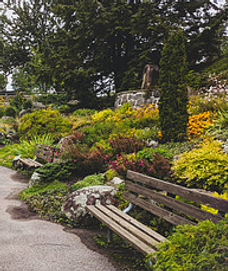
The gardener’s quest is to sit back, relax, and reap the benefits of the glorious blossoms throughout the entire blooming season. In other words, have continuous blooming perennials throughout spring, summer and fall. Wouldn’t it be wonderful to do the minimal of dead-heading and pulling a few untidy weeds from the garden rather than constantly planting and replanting flowers in order to achieve maximum blooms? Follow my suggestions and you’ll be rewarded with not only a garden with an abundance of flowers, but beautiful bouquets to adorn your home and to share with friends and family.
(Some of the links within this post are affiliate links on which I receive a small compensation from the sale of certain items.)
(As an Amazon Affiliate I earn from qualifying purchases.)
First Things First – Amend the Soil
You must make sure your soil is fertile enough to produce long-lasting flowers. The soil must be a mixture of loam, sand and a small amount of clay. Find complete instructions by referring to my previous blog on how to prepare the soil for gardening.
Now a Little Education – Succession Planting
If you desire continuous blooms in your garden, begin by understanding the technique of succession planting. This method involves planting specific flowers to guarantee blooms that flower in succession throughout the entire growing season. You will have continuous blooms by planting bulbs and perennials along with a few flowering bushes and annuals scattered throughout to fill the gaps in your garden.
Implementation
To implement this method, first create one group of plants that bloom at
different times or seasons; that is early bloomers, mid-season bloomers, and late season bloomers. Select groupings of odd numbered plants. One group could be 3 to 5 bulbs of daffodils (early blooms), 3 to 5 autumn joys (mid-season blooms), and 3 to 5 liriope (late season blooms). The size of the garden will determine how many plants or bulbs of each type of flower you choose in each all season blooming group.
Within this each group, separate each section according to bloom time: early blooms, mid-summer blooms and late blooms. Now add plants with varying heights to each individual group.
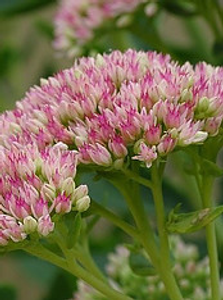
Layering or Tiers/ Spring
(For the early blooming section of your group.)

In addition to arranging plants according to bloom times group them according to height. You want to layer or create tiers of flowers with mostly tall flowers in the back, medium sized ones in the middle and shorter flowers in the front. For your spring blooming group add a camellia bush, azalea or rhododendron (the tallest flowers). The next layer which would be shorter plants could include tulips and daffodils. Finally crocus and grape hyacinths are added to the shortest layer in the spring grouping.
Layering or Tiers/ Summer
(Add the following to the mid-summer blooming section of your group.)
You now want to add height to the mid-summer blooms to create a layering effect. Some suggestions for mid-summer blooming shrubs include rose of Sharon, dwarf crepe myrtles, sonic bloom pink weigela, or rosa rugosa. The middle layer could include gladiolus, bearded iris, salvia, shasta daisies, black eyed susans, coreopsis, yarrow, or autumn joy. Liriope, summer phlox, and hosta could be added to the smaller, front layer.
Layering or Tiers/ Late Summer into Fall
(Add the following to the late season blooming section of your group.)

Lastly, add varying heights of plants to the late season section to create a tiered effect. A butterfly bush and rose of Sharon will last from mid-summer through the fall. Bluebeard shrub and crepe myrtles will also last into the autumn. These are all considered tall varieties of plants and should be planted in the back of your garden. Next add chrysanthemums to the middle layer. Daisies and asters added to the mid-summer section will continue blooming into the fall. A turtlehead plant grows in a dense clump and prefers a damp area in your garden. This plant can be used for the shorter layer.

Continuous blooming perennials
Summary/ Continuous Blooming Perennials
You want to have multiple sections of flowers. Each section will contain subsections.
Section 1: Early Summer Blooms
- 1 shrub (tall)
- 3 to 5 medium sized plants
- 3 to 5 shorter plants
Section 2: Mid-Summer Blooms
- 1 shrub (tall)
- 3 to 5 medium sized plants
- 3 to 5 shorter plants
Section 3: Late Summer to Fall Blooms
- 1 shrub (tall)
- 3 to 5 medium sized plants
- 3 to 5 shorter plants

Time to Spend Some Money
Now that you have the groupings identified and you have decided which plants you would like to purchase, it’s time to buy your flowers. Take a measurement of your garden and draw a diagram of it onto a large piece of graph paper. Create a scale using the blocks on the paper. For instance, one block could equal one square foot or 5 blocks could represent one square foot depending on the size of the graphing paper and your garden.
Off to the Garden Store
Take the diagram with you to the garden supply store along with colored pencils. Using the colored pencils and a list of the flowers you would like to purchase, draw circles of each plant with the appropriate bloom color onto the paper. Label each circle with the name of the flower. Use the scale as a guide so you do not overbuy. Remember to allow for growth and plot the plant on your graphing paper in their mature state.
When buying medium sized plants you may want to buy only one because they could spread two to three feet wide. Read the tags on the plants to get some idea of their mature size.
It’s Planting Time! – The Fun Part
Now that you have your plants and a chart, start creating your patterns throughout the garden using the sections you planned above and charted on your diagram. It’s similar to a material pattern with repeats. Plant one grouping then repeat with the next grouping and the next. In this way you will have continuus blooming perennials throughout the season. You don’t have to follow the strict pattern, though. Once you familiarize yourself with the times the flowers bloom and the heights of each you’ll be able to create unique flowing repeated patterns on your own. You can repeat the pattern throughout your garden as many times as you’d like depending on the size of the area.
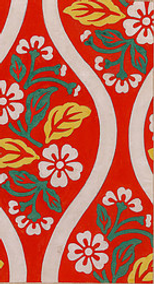
For the Most Attractive Look
1. Each grouping should have all three seasons of flowers along with tall to short varieties of flowers.
2. Plant your flowers and shrubs close enough together to allow for some foliage overlap. Remember to take into consideration their adult size.
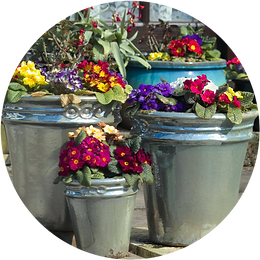
3. Spring growth is usually minimal so plant early spring, mid-spring and late spring bulbs scattered throughout your garden. In this way you will have color along with the beginning sprigs of your perennials. (Bulbs are usually planted in the fall so hold off on planting these until September or October if you live in the Northern Hemisphere. Reverse it if you live in the Southern Hemisphere.)
4. Research when the best time is to plant the flowers and shrubs you chose. It may take a full season to plant your garden to have a continuous blooming garden.
5. While waiting for your perennials to reach full shape, scatter pots filled with annuals in the bare spots. You can move these pots around the garden to fill in other vacant spots after your perennials begin flourishing.
One Other Consideration – Color
You want to have colors that complement each other when planting a garden. Consider the color wheel. Opposite sides of the color wheel complement each other. Colors adjacent (or side by side) to each other also look good together.
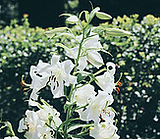
Color Alternatives
- warm colors (reds, yellows, and oranges or shades of these)
- cool colors (green, blue, and purple and variations of these)
- monochromatic (all the same color)
Remember that when selecting the flowers, consider the size of the plant and in which season they blossom.

Take Care Of Those Babies!!
Here are some last minute tips to make sure your flowers produce lovely blooms throughout the entire season.
- Supply rich soil to the garden
- Dead head (snipping off the dead flowers) often
- Fertilize your plants
- Provide lots of sunlight (think about where the sun is before plotting your garden)
- Nurse the roots (when transplanting flowers from containers, gently untangle the roots and carefully pack the soil around the roots when planting in the ground)
- Apply 2 to 3 inches of good mulch to your garden
- Moderately water your garden
Well, That’s All Folks!
I know this sounds a bit daunting but do not be scared off by that. My advice to you is to start small. Become acquainted with specific flowers including blooming times and sizes. It will be less overwhelming if you keep it simple and start small.
I hope you enjoyed this post on creating continuous blooming perennials. I have tried to simplify the process and I hope I succeeded. If you have any questions or comments on this topic, please leave them below. I’d love to hear from you!
Happy Gardening
Nina
bestgardeningforbeginners@gmail.com
